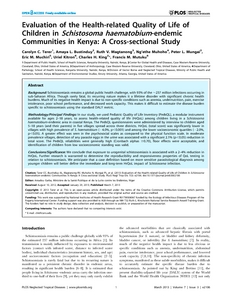Terer, CC; Bustinduy, AL; Magtanong, RV; Muhoho, N; Mungai, PL; Muchiri, EM; Kitron, U; King, CH; Mutuku, FM
(2013)
Evaluation of the health-related quality of life of children in Schistosoma haematobium-endemic communities in Kenya: a cross-sectional study.
PLoS Neglected Tropical Diseases, 7 (3).
ISSN 1935-2735
https://doi.org/10.1371/journal.pntd.0002106
SGUL Authors: Bustinduy, Amaya Lopez
![[img]](https://openaccess.sgul.ac.uk/107282/1.hassmallThumbnailVersion/Evaluation_health_related_quality_life_children.pdf)  Preview |
|
["document_typename_application/pdf; charset=binary" not defined]
Published Version
Download (468kB)
| Preview
|
Abstract
BACKGROUND: Schistosomiasis remains a global public health challenge, with 93% of the ~237 million infections occurring in sub-Saharan Africa. Though rarely fatal, its recurring nature makes it a lifetime disorder with significant chronic health burdens. Much of its negative health impact is due to non-specific conditions such as anemia, undernutrition, pain, exercise intolerance, poor school performance, and decreased work capacity. This makes it difficult to estimate the disease burden specific to schistosomiasis using the standard DALY metric.
METHODOLOGY/PRINCIPAL FINDINGS: In our study, we used Pediatric Quality of Life Inventory (PedsQL), a modular instrument available for ages 2-18 years, to assess health-related quality of life (HrQoL) among children living in a Schistosoma haematobium-endemic area in coastal Kenya. The PedsQL questionnaires were administered by interview to children aged 5-18 years (and their parents) in five villages spread across three districts. HrQoL (total score) was significantly lower in villages with high prevalence of S. haematobium (-4.0%, p<0.001) and among the lower socioeconomic quartiles (-2.0%, p<0.05). A greater effect was seen in the psychosocial scales as compared to the physical function scale. In moderate prevalence villages, detection of any parasite eggs in the urine was associated with a significant 2.1% (p<0.05) reduction in total score. The PedsQL reliabilities were generally high (Cronbach alphas ≥0.70), floor effects were acceptable, and identification of children from low socioeconomic standing was valid.
CONCLUSIONS/SIGNIFICANCE: We conclude that exposure to urogenital schistosomiasis is associated with a 2-4% reduction in HrQoL. Further research is warranted to determine the reproducibility and responsiveness properties of QoL testing in relation to schistosomiasis. We anticipate that a case definition based on more sensitive parasitological diagnosis among younger children will better define the immediate and long-term HrQoL impact of Schistosoma infection.
| Item Type: |
Article
|
| Additional Information: |
©2013 Terer et al. This is an open-access article distributed under the terms of the Creative Commons Attribution License, which permits unrestricted use, distribution, and reproduction in any medium, provided the original author and source are credited. |
| Keywords: |
Adolescent, Animals, Child, Child, Preschool, Cross-Sectional Studies, Female, Humans, Kenya, Male, Quality of Life, Questionnaires, Schistosoma haematobium, Schistosomiasis haematobia, Tropical Medicine, 06 Biological Sciences, 11 Medical And Health Sciences |
| SGUL Research Institute / Research Centre: |
Academic Structure > Infection and Immunity Research Institute (INII) |
| Journal or Publication Title: |
PLoS Neglected Tropical Diseases |
| Article Number: |
e2106 |
| ISSN: |
1935-2735 |
| Language: |
eng |
| Dates: |
| Date | Event |
|---|
| 7 March 2013 | Published |
|
| PubMed ID: |
23505590 |
 |
Go to PubMed abstract |
| URI: |
https://openaccess.sgul.ac.uk/id/eprint/107282 |
| Publisher's version: |
https://doi.org/10.1371/journal.pntd.0002106 |
Statistics
Item downloaded times since 21 Jan 2015.
Actions (login required)
 |
Edit Item |



